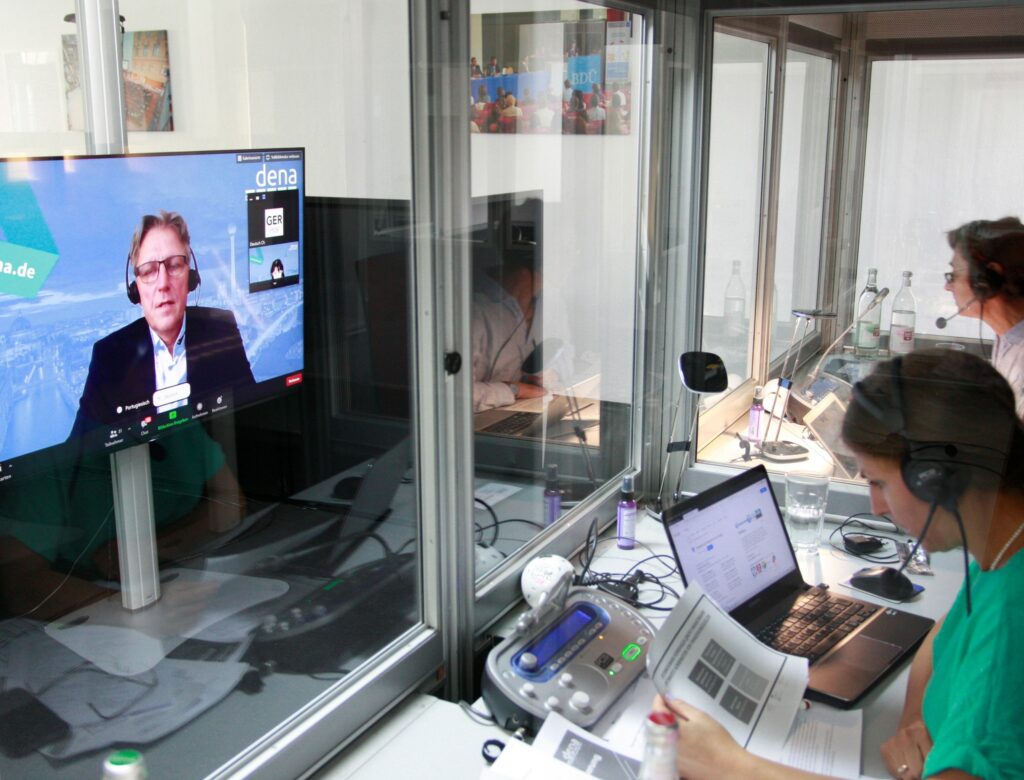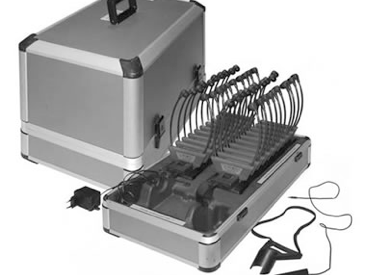Interpreting
Interpreting Services – Always in the Right Format
Some of our translators also offer interpreting services. Which one would you like to use?
There are four main types of interpreting: simultaneous interpreting, consecutive interpreting, liaison interpreting, and whispered interpreting – all of which are available either in person and/or virtually.
Various specialized equipment can make interpreting easier. One example: the infoport.
There are four main types of interpreting: simultaneous interpreting, consecutive interpreting, liaison interpreting, and whispered interpreting – all of which are available either in person and/or virtually.
Various specialized equipment can make interpreting easier. One example: the infoport.
Simultaneous Interpreting
In simultaneous interpreting, a speech is translated in real time, with only a few seconds’ delay. Interpreters require technical equipment such as soundproof booths, microphones, and headphones. This equipment can either be rented or provided by us for your convenience.
Simultaneous interpreting is mainly used at international conferences or events where several languages are spoken at the same time. Because simultaneous interpreting requires a high level of concentration, interpreters switch every 30 minutes.


Consecutive Interpreting
Consecutive interpreting is well-suited for small meetings, interviews, and public speeches. The speaker regularly pauses to allow the interpreter to speak, either during or at the end of each segment. The interpreter relies on handwritten notes to render the message accurately. Because of this pause-and-interpret format, consecutive interpreting typically takes about twice as long as simultaneous interpreting.
This method can actually be more demanding than simultaneous interpreting, as it requires the interpreter to retain and reproduce longer stretches of speech. It's also a practical solution in settings where technical equipment isn't available.
Liaison Interpreting
Liaison interpreting is a specific form of consecutive interpreting, typically used in bilateral meetings, small discussions, or negotiations. These settings involve a limited number of participants and an interpreter. The conversation is interpreted consecutively, either aloud or informally through whispered translation.


Whispered Interpreting
Whispered interpreting is intended for one or two listeners at most. The interpreter sits or stands close to them and delivers a real-time translation of the speaker’s words in a low voice. This technique is especially suited to informal settings or situations where only a small portion of the audience requires interpretation.
Infoport
During guided tours or site inspections — where participants and interpreters are on the move — a portable interpreting system can be incredibly useful. Commonly referred to as a “bidule” (literally “gadget”), this lightweight, wireless setup includes one or more microphone transmitters and headset receivers. It’s especially handy in situations where whispering isn’t practical or where discretion and mobility are key.

Other Key Information About Interpreting
How many interpreters will I need?
Interpreting is demanding, high-concentration work. That’s why it’s usually best to hire a team of interpreters rather than relying on just one person —unless the meeting is very short. In simultaneous interpreting, it’s rare for a single interpreter to work alone, as the mental strain is simply too high. For consecutive or whispered interpreting, working solo may be feasible, but keep in mind that maintaining focus and delivering consistent quality over several hours can be extremely challenging for any interpreter.
How Are Interpreters’ Fees Calculated?
In Switzerland — as in most parts of the world — interpreting services are billed on a daily basis. This is because interpreters need to block out the entire day, regardless of how long the actual assignment lasts. They won’t be available for any other work that day.
In addition, interpreters typically spend several hours preparing in advance — researching terminology, understanding the context, and making sure they’re fully ready to deliver a high-quality performance.
In Switzerland — as in most parts of the world — interpreting services are billed on a daily basis. This is because interpreters need to block out the entire day, regardless of how long the actual assignment lasts. They won’t be available for any other work that day.
In addition, interpreters typically spend several hours preparing in advance — researching terminology, understanding the context, and making sure they’re fully ready to deliver a high-quality performance.
But My Meeting Only Lasts an Hour!
The fee also covers preparation time. Interpreters invest significant effort in advance to understand the purpose of your meeting, who will be attending, what their interests are, and which topics will be discussed. They also take time to familiarize themselves with your specialized vocabulary — and how it translates into the other working languages.
Even a one-hour meeting can require several hours of preparation.That said, rates are negotiable and depend on the nature of the assignment. There are very few price differences between languages. Our interpreters will be happy to provide you with a free quote.
The fee also covers preparation time. Interpreters invest significant effort in advance to understand the purpose of your meeting, who will be attending, what their interests are, and which topics will be discussed. They also take time to familiarize themselves with your specialized vocabulary — and how it translates into the other working languages.
Even a one-hour meeting can require several hours of preparation.That said, rates are negotiable and depend on the nature of the assignment. There are very few price differences between languages. Our interpreters will be happy to provide you with a free quote.
Things to Consider in Advance:
International Association of Conference Interpreters AIIC
- The interpreting method you choose should match the format of your meeting.
- Make sure you know which language combinations will be needed during the session.
- Interpreters typically work in teams, as the job is highly demanding.
International Association of Conference Interpreters AIIC
